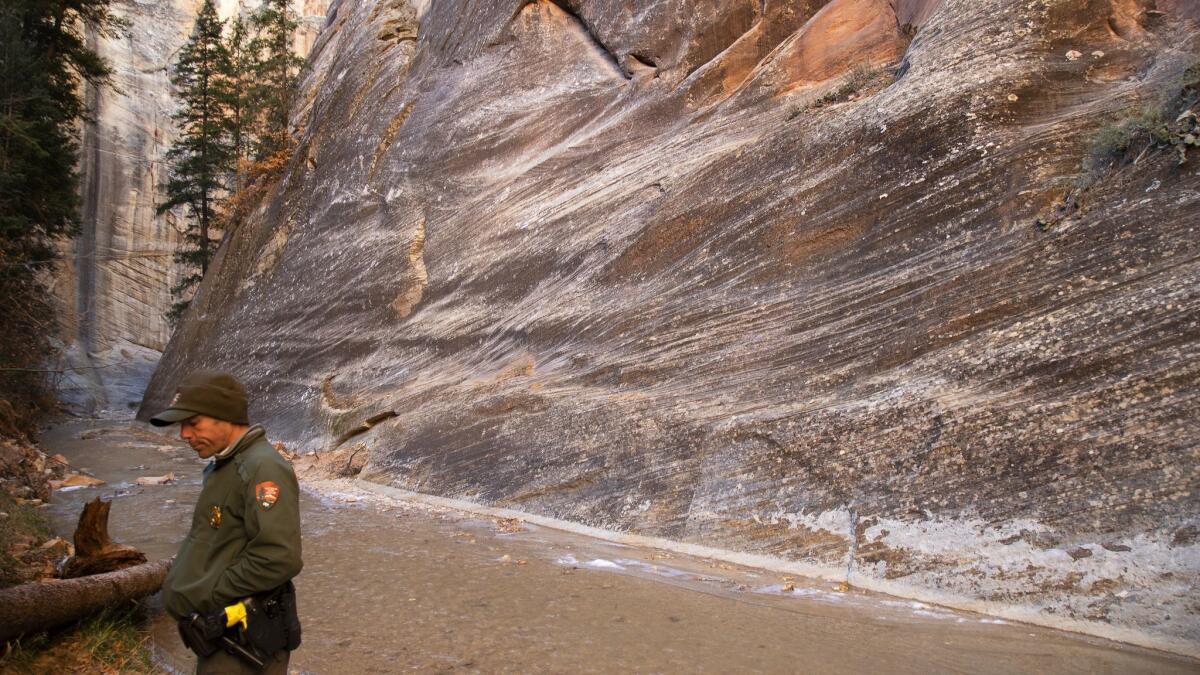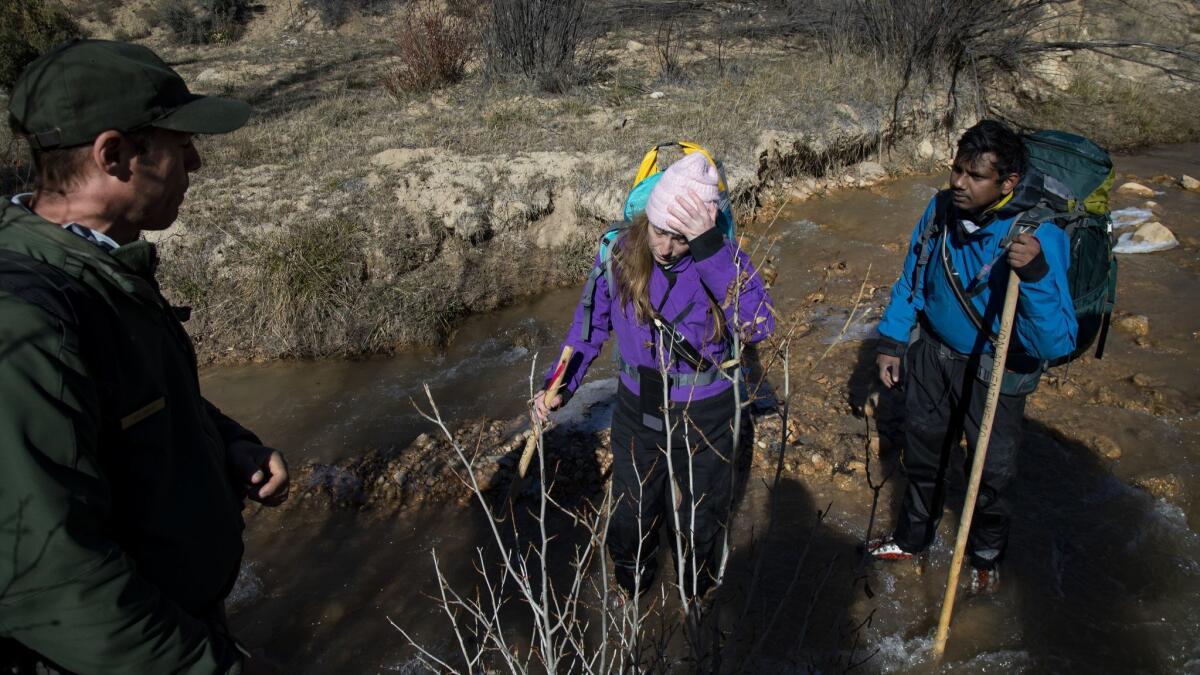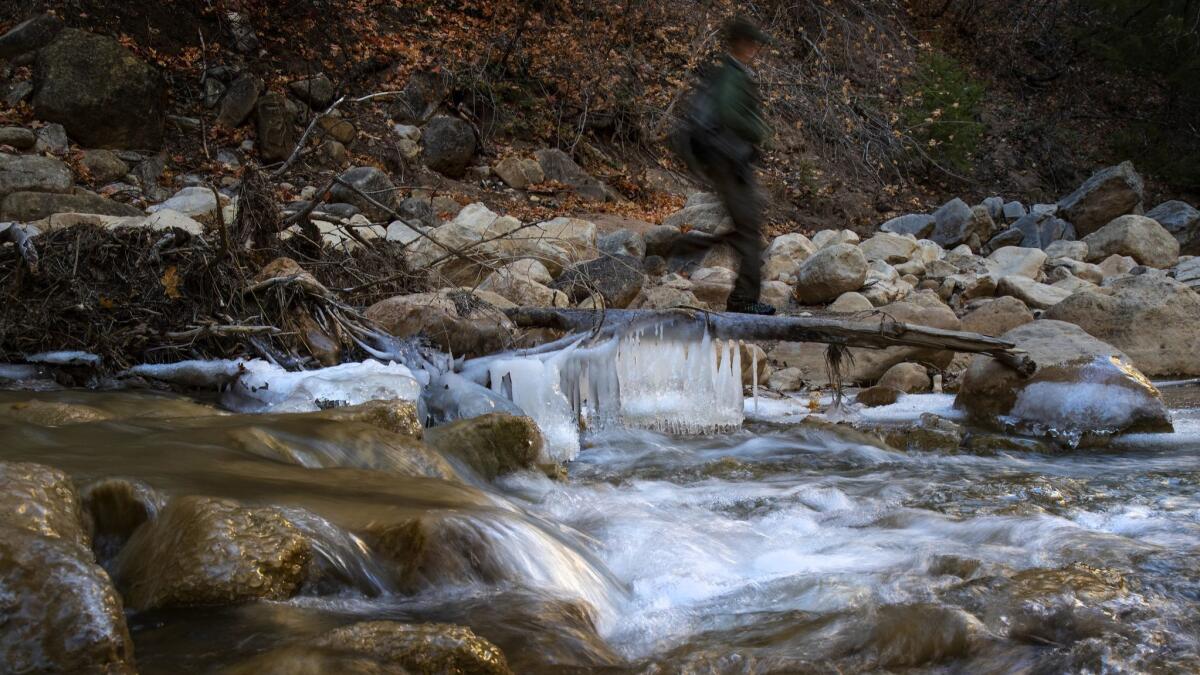Dispute between landowner and government threatens access to treasured trail in Utah’s Zion National Park

- Share via
Reporting from Springdale, Utah — The two of them walked slowly in the middle of the ice-cold river, bundled in layers and using their walking sticks to probe the rocky bed for safe footing.
Annie Kitchen had wanted to do this hike for years. So had Rama Rauitalai.
“Nature. Solitude. Quiet,” Rauitalai said in a voice so soft it was nearly drowned out by the water’s steady current. Above them, the sky was periwinkle and the sun promised more warmth than it was delivering.
They had begun the top-down hike of the Narrows at Zion National Park in Utah in early November because permits were easier to obtain. During the summer, it’s a lottery system. Only 90 people are allowed through the top-down hike daily and the permits are reserved months in advance. During the winter, snow and cold make access to the trailhead at Chamberlain Ranch mostly inaccessible to hikers.
“We’d been to Zion before, but never done the Narrows,” said Kitchen, 34, of Phoenix. “I’d heard stories and seen pictures and it looked amazing.”
But Kitchen and Rauitalai, also from Phoenix, could be among the last few people to hike the top-down 16-mile route through the Narrows unless a dispute between a private property owner and the federal government is resolved by a Dec. 31 deadline.
Local resident Scott Bulloch owns hundreds of acres of land that is cut by the Virgin River and, for about 50 years, he and his family have allowed hikers to traverse through it on their way to the Temple of Sinawava, one of the park’s most popular destinations.
Bulloch’s attorney, Barry Clarkson, said the family had wanted a permanent solution to the public-private land issue and a few years ago asked whether the federal government would like to purchase it or set up a conservation easement.
Government officials were agreeable to the idea.
The property includes Simon Gulch, a spectacular canyon of walls smoothed by millions of years of wind and river water — clear, with a turquoise tint. There are tall trees and hidden wildlife that include mountain lions, bighorn sheep and ringtail cats.
It’s a place that was made for photography before cameras were ever imagined, but years ago it became the Bullochs’ backyard.

Christopher Hansen, a Park City-based appraiser who was commissioned by the Trust for Public Land, a nonprofit organization, to come up with a price for the 880 acres, spent time at Simon Gulch and surveyed the raw land during the summer.
Hansen factored in the most spectacular scenery as well as acreage best used by grazing cattle. He thought he’d nailed down a price everyone would agree upon and delivered the dollar figure, which remained undisclosed to the public, in the summer.
The U.S. Forest Service, which had the final say, rejected it, startling Hansen, who has decades of appraisal experience. The Trust for Public Land was chagrined the process had stalled. The Bulloch family was not happy either.
“That was upsetting to my clients,” Clarkson said.
Up went signs warning about trespassing and down went hopes of an immediate resolution.
National Park Service officials stopped issuing permits to hike and camp for top-down hikers. Springdale-based companies that shuttled people up to the Chamberlain Ranch trailhead to do the top-down hike worried about lost revenue amid a prolonged closure.
Eager to resolve the issue, officials from Washington County offered to help mediate the dispute and Bulloch agreed to take down the signs, meaning access through Simon Gulch would be permissible through the end of the year.
Zion National Park Supt. Jeff Bradybaugh said in a statement that officials “greatly appreciate the goodwill of the landowners” in an attempt to help resolve the conflict.
A new firm is doing an appraisal of the Bulloch property and is expected to provide its findings in mid-December. Because the Hansen appraisal wasn’t accepted by the Forest Service, its dollar figure was not made public.
Susanne Tracy, spokeswoman for the Forest Service, said in an email that her agency had completed a technical review of Hansen’s appraisal to determine whether it complied with the Uniform Appraisal Standards for Federal Land Acquisitions and found it did not.
“The Forest Service review concluded that the appraisal did not comply with these standards, and disapproved the appraisal as the basis for acquisition of the Simon Gulch easement,” Tracy wrote.
Hansen said in a phone interview that the government was smearing his reputation and making the Bullochs out to be unreasonable and unwilling sellers.
They aren’t, he said.
“I view the government as being oppressive in this process and don’t want to pay the fair price,” Hansen said.

Zion National Park, which celebrated its 99th birthday this year, was established as Utah’s first national park by President Woodrow Wilson, but it has long had some access-point disputes.
Greg Hiner, southwest director of land protection for the Trust for Public Land, said the organization has been trying to assist in establishing conservation easements throughout Zion National Park’s 147,000 acres for several years. Last month, the trust announced a donation to the National Park Service of a 35-acre inholding known as Firepit Knoll in the Kolob Terrace. That purchase will protect it from future development.
Hiner said access to the Narrows is a high priority for everyone given its popularity. In 2013, the trust worked out a conservation easement deal with the owners of the Chamberlain Ranch trailhead to provide access into the canyon. He said he remains hopeful a deal can be worked out with the Bullochs.
“I think everybody wants to see it done — and I include the Bulloch family in that,” Hiner said. “The park service wants to get it done, and the Forest Service I think wants to get it done. Everybody wants a solution here.”
But for a few days in September, some outdoor outfitting companies that shuttle people to the Chamberlain Ranch trailhead saw what things might look like if a resolution isn’t reached before the snow melts and spring hikers start arriving at Zion.
Andy Gonyou, a hiking guide with Zion Guru, said when the signs went up, it provided an ominous glimpse of what could be. He worried that prospective hikers could be scared away.
“A lot of people travel literally from all over the world” to hike the Narrows, he said, “so if you have your set time, and it was closed those five days, people didn’t necessarily have the flexibility in their schedule to do it a different day,” Gonyou said. “They were just kind of out of luck.”
Tim Knaus, a park ranger who has made the hike several times, said each time he goes out, he finds a new grotto or cave that he’d missed before. In the summer, he said the cool water from the river provides welcome relief from the triple-digit heat that can warm the canyons. What the park offers, Knaus said, is a connection to nature and a place of peace in the midst of a loud, busy world. A place, he said, he would like accessible to everyone.
“The parks provide perspective,” he said.
The Bullochs say they too want the public to be able to access the Narrows through the top-down hike. Scott Bulloch, who declined an interview with The Times, told the Salt Lake Tribune last month that the issue involves a matter of fairness.
“When the Forest Service people came down and looked at the [Simon Gulch] property, they said this land is priceless. Yet they don’t want to give us anything for it,” Bulloch said. “You can’t compare it with neighboring ranch land because it is the only property with the Zion Narrows.”
david.montero@latimes.com | Twitter: @davemontero
More to Read
Sign up for Essential California
The most important California stories and recommendations in your inbox every morning.
You may occasionally receive promotional content from the Los Angeles Times.














